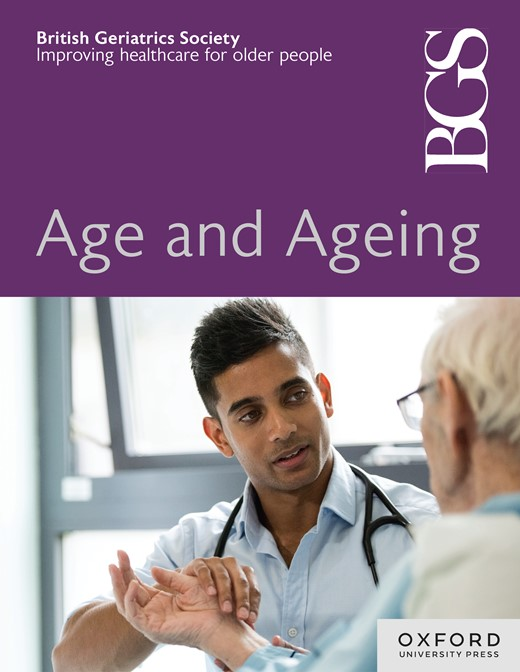3055 Is appetite related to the occurrence of future falls in older adults with upper limb fracture?
IF 7.1
2区 医学
Q1 GERIATRICS & GERONTOLOGY
引用次数: 0
Abstract
Introduction Older people can commonly experience reduced appetite and it can be assessed very simply by questionnaires such as the Simplified Nutritional Appetite Questionnaire (SNAQ). Decreased appetite is associated with sarcopenia and frailty, which in turn are related to falls. The aim is to assess if screening for poor appetite might aid in predicting risk of future falls by exploring association between appetite score and falls at three and six months in older people with upper limb fracture. Methods A secondary data analysis. Baseline appetite was assessed using the SNAQ, with score < 14/20 defining poor appetite. Descriptive statistics summarised characteristics associated with poor appetite. Association between baseline characteristics and the presence of falls at 3 and 6 months were measured using logistic regression. Results 100 participants (80% females and 20% males, median age 73 years (IQR 9.75)). 9% had poor appetite. Sarcopenia (SARC-F score ≥ 4), frailty (FRIED phenotype) and a higher number of comorbidities and medications were more prevalent in individuals with poor appetite. Appetite at baseline was not related to occurrence of falls at 3 and 6 months (P = 0.627, P = 0.698 respectively). Sarcopenia, number of comorbidities, EQ5D5L mobility, EQ5D5L self-care and EQ5D5L activities were associated with occurrence of falls at 3 months. There was no relationship between baseline variables and falls at 6 months. In multivariate analysis, the association between EQ5D5L activities and the presence of falls at 3-months remained (OR 3.485 (95% CI 1.463, 8.302), P = 0.005). Conclusion In this study population, poor appetite was related to higher prevalence of sarcopenia and frailty but was not predictive of future falls. Sarcopenia, comorbidities, EQ5D5L mobility and self-care were associated with falls at 3 months. Identifying individuals with sarcopenia and difficulty in performing routine activities continues to be imperative to minimise the risk of future falls.3055上肢骨折的老年人食欲是否与未来跌倒的发生有关?
老年人通常会经历食欲下降,这可以通过简单的问卷来评估,如简化营养食欲问卷(SNAQ)。食欲下降与肌肉减少症和虚弱有关,而肌肉减少症和虚弱又与跌倒有关。目的是通过探索上肢骨折的老年人在3个月和6个月时的食欲评分与跌倒之间的关系,评估食欲差筛查是否有助于预测未来跌倒的风险。方法二次资料分析。使用SNAQ评估基线食欲,评分为&;lt;14/20定义胃口不好。描述性统计总结了与食欲不振相关的特征。使用逻辑回归测量基线特征与3个月和6个月时出现跌倒之间的关联。结果100名参与者(女性80%,男性20%,中位年龄73岁(IQR 9.75))。9%的人食欲不振。肌肉减少症(SARC-F评分≥4)、虚弱(FRIED表型)以及更多的合并症和药物治疗在食欲差的个体中更为普遍。基线时的食欲与3个月和6个月时的跌倒发生率无关(P = 0.627, P = 0.698)。骨骼肌减少症、合并症数量、EQ5D5L活动能力、EQ5D5L自我护理和EQ5D5L活动与3个月时跌倒的发生有关。基线变量与6个月时的跌倒没有关系。在多变量分析中,EQ5D5L活性与3个月时出现跌倒之间的关联仍然存在(OR 3.485 (95% CI 1.463, 8.302), P = 0.005)。结论:在本研究人群中,食欲不佳与肌肉减少症和虚弱的高发率有关,但不能预测未来的跌倒。骨骼肌减少症、合并症、EQ5D5L活动能力和自我护理与3个月时的跌倒有关。识别患有肌肉减少症和日常活动困难的个体仍然是必要的,以尽量减少未来跌倒的风险。
本文章由计算机程序翻译,如有差异,请以英文原文为准。
求助全文
约1分钟内获得全文
求助全文
来源期刊

Age and ageing
医学-老年医学
CiteScore
9.20
自引率
6.00%
发文量
796
审稿时长
4-8 weeks
期刊介绍:
Age and Ageing is an international journal publishing refereed original articles and commissioned reviews on geriatric medicine and gerontology. Its range includes research on ageing and clinical, epidemiological, and psychological aspects of later life.
 求助内容:
求助内容: 应助结果提醒方式:
应助结果提醒方式:


